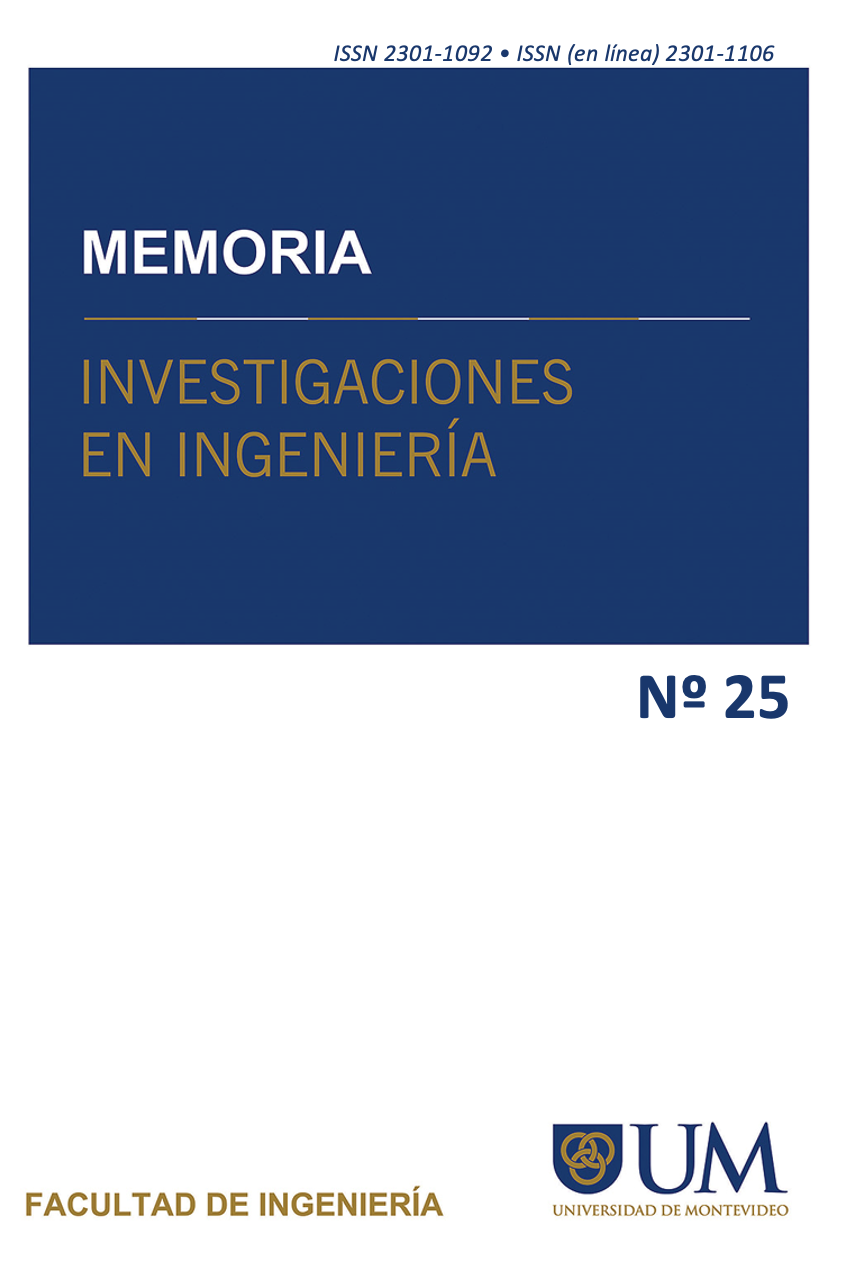Um estudo baseado em simulação sobre o efeito de nanopartículas metálicas e não metálicas no desempenho do concentrador de calha parabólica
DOI:
https://doi.org/10.36561/ING.25.10Palavras-chave:
Concentrador de calha parabólica, Nanopartículas metálicas, Nanopartículas não metálicas, Nanofluidos à base de águaResumo
Esta pesquisa investiga o desempenho baseado em simulação de nanopartículas metálicas e não metálicas, juntamente com fluidos de transferência de calor à base de água, utilizados em concentradores de calha parabólica. Seu principal objetivo é analisar a melhoria de desempenho do concentrador, dividido em duas fases. A primeira fase concentra-se na validação da configuração experimental utilizando dinâmica de fluidos computacional através do software ANSYS. O mesmo modelo de simulação validado é então utilizado para avaliar o desempenho do concentrador solar parabólico com diferentes nanofluidos metálicos e não metálicos, além de nanofluidos à base de água. O estudo utiliza apenas água, juntamente com cobre, ouro e prata, e duas nanopartículas não metálicas, óxido de alumina e óxido de cobre, em concentrações volumétricas variadas de 1% a 3%. A análise de simulação, realizada a uma velocidade de 0,12 m/s, revela que o maior aumento médio de temperatura é observado no caso do nanofluido à base de alumina + água na concentração volumétrica de 3%, com transferência de calor média máxima de 351,89 watts. Além disso, o nanofluido à base de prata + água demonstra o maior valor médio do coeficiente de transferência de calor convectivo em 88.055,5 W/(m2 K). O nanofluido à base de ouro + água apresenta um valor médio mais elevado do Número de Reynolds em 4352,268, enquanto o número máximo de Nusselt é observado com óxido de alumina + nanofluido à base de água, medindo 1,7698.
Downloads
Referências
Al-Oran, Otabeh & A'saf, Ahmad & Lezsovits, Ferenc. (2022). Experimental and modelling investigation on the effect of inserting ceria-based distilled water nanofluid on the thermal performance of parabolic trough collectors at the weather conditions of Amman: A case study. Energy Reports. 8. 4155-4169. https://10.1016/j.egyr.2022.03.030.
Al-Oran, Otabeh & Lezsovits, Ferenc & Aljawabrh, Ayham. (2020). Exergy and energy amelioration for parabolic trough collector using mono and hybrid nanofluids. Journal of Thermal Analysis and Calorimetry. 140. https://10.1007/s10973-020-09371-x.
Abed, Nabeel & Afgan, Imran & Iacovides, H. & Cioncolini, Andrea & Khurshid, Ilyas & Nasser, Adel. (2021). Thermal-Hydraulic Analysis of Parabolic Trough Collectors Using Straight Conical Strip Inserts with Nanofluids. Nanomaterials. 11. https://10.3390/nano11040853.
Ajbar, Wassila & Perez, J A & Parrales, Arianna & Torres, Lizeth. (2023). Thermal efficiency improvement of parabolic trough solar collector using different kinds of hybrid nanofluids. Case Studies in Thermal Engineering. 42. 102759. https://10.1016/j.csite.2023.102759.
Benabderrahmane, Amina & Miloud, Aminallah & Samir, Laouedj & Benazza, Abdelilah & Solano, Juan. (2016). Heat Transfer Enhancement in a Parabolic Trough Solar Receiver using Longitudinal Fins and Nanofluids. Journal of Thermal Science. 25. 410-417. https://10.1007/s11630-016-0878-3.
Bellos, Evangelos & Tzivanidis, Christos. (2018). Thermal efficiency enhancement of nanofluid-based parabolic trough collectors. Journal of Thermal Analysis and Calorimetry. 135. https://10.1007/s10973-018-7056-7.
Bharti, Alka & Mishra, Abhishek & Paul, Bireswar. (2019). Thermal performance analysis of small-sized solar parabolic trough collector using secondary reflectors. International Journal of Sustainable Energy. 38. 1-21. https://10.1080/14786451.2019.1613991.
Dupeyrat, Patrick & Ménézo, Christophe & Fortuin, Stefan. (2014). Study of the thermal and electrical performances of PVT solar hot water system. Energy and Buildings. 68. 751-755. https://10.1016/j.enbuild.2012.09.032.
Ekiciler, Recep, et al., Effect of hybrid nanofluid on heat transfer performance of parabolic trough solar collector receiver. Term. Anal. Calorim. 2021; 143 (2), 1637-1654
https://doi.org/10.1007/s10973-020-09717-5.
Ghasemi, Seyed Ebrahim and A. A. Ranjbar. “Thermal performance analysis of solar parabolic trough collector using nanofluid as working fluid: A CFD modelling study.” Journal of Molecular Liquids 222 (2016): 159-166.
Govindaraj, Kumaresan & Sudhakar, Padmanabhan & Ravichandran, Santosh & Velraj, R. (2017). Experimental and numerical studies of thermal performance enhancement in the receiver part of solar parabolic trough collectors. Renewable and Sustainable Energy Reviews. 77. https://10.1016/j.rser.2017.01.171.
Gupta, Munish & Ahlawat, Vinay & Kumar, Rajesh & Said, Zafar. (2017). A review on thermophysical properties of nanofluids and heat transfer applications. Renewable and Sustainable Energy Reviews. 74. 638-670. https://10.1016/j.rser.2017.02.073.
H.M. Sandeep, U.C. Arunachala, Solar parabolic trough collectors: A review on heat transfer augmentation techniques, Renewable and Sustainable Energy Reviews, Volume 69, 2017, Pages 1218-1231, ISSN 1364-0321,https://doi.org/10.1016/j.rser.2016.11.242.
Kaloudis, Efstathios & Papanicolaou, E. & Belessiotis, V.. (2016). Numerical simulations of a parabolic trough solar collector with nanofluid using a two-phase model. Renewable Energy. 97. 218-229. https://10.1016/j.renene.2016.05.046.
Khanafer, Khalil & Vafai, Kambiz. (2011). A critical synthesis of thermophysical characteristics of nanofluids. International Journal of Heat and Mass Transfer - INT J HEAT MASS TRANSFER. 54. https://10.1016/j.ijheatmasstransfer.2011.04.048.
Lewis, Nathan & Nocera, Daniel. (2006). Powering the Planet: Chemical Challenges in Solar Energy Utilization. Proceedings of the National Academy of Sciences of the United States of America. 103. 15729-35. https://10.1073/pnas.0603395103.
Owusu, Phebe Asantewaa & Asumadu Sarkodie, Samuel. (2016). A Review of Renewable Energy Sources, Sustainability Issues and Climate Change Mitigation. Cogent Engineering. 3. 1167990. https://10.1080/23311916.2016.1167990.
Patil M.S., hekhawat S.P. Performance Assessment of Parabolic Trough Collector Receiver with Al2O3 Nanofluid. J. Water Environ. Nanotechnol., 2022; 7(3): 332-343.
DOI: https://10.22090/jwent.2022.03.008.
Shyam, A., Ahmed, K.R.A., Christopher, S.S. et al. Thermal performance enhancement in a solar parabolic trough collector with optimized secondary optics. Clean Techn Environ Policy (2023). https://doi.org/10.1007/s10098-023-02649-2
Tagle, Pablo & Nigam, K.D.P. & Rivera-Solorio, Carlos. (2018). Heat transfer model for thermal performance analysis of parabolic trough solar collectors using nanofluids. Renewable Energy. https://125. 10.1016/j.renene.2018.02.069.
Uzair, M., & Rehman, N. U. (2021). Intercept factor for a beam-down parabolic trough collector. Journal of Solar Energy Engineering, 143(6), 061002.
Uzair, M., ur Rehman, N., & Raza, S. A. (2018). Probabilistic approach for estimating heat fluid exit temperature correlation in a linear parabolic trough solar collector. Journal of Mechanical Science and Technology, 32, 447-453.
Publicado
Como Citar
Edição
Seção
Licença
Copyright (c) 2023 Muhammad Asif Ali, Muhammad Uzair

Este trabalho está licenciado sob uma licença Creative Commons Attribution 4.0 International License.






















